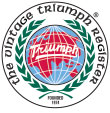Complete Interior Restoration
by Bill Beamon, of Internet British-Cars list
When I decided to restore my car’s interior, I was faced with a trade-off between cost and effort: How much you are willing to pay someone to do all the work versus how much time and effort you are willing to contribute yourself. With sufficient excess funds, many of us with older British cars would probably own a different kind of vehicle rather than be involved with the knuckle busting hassles of keeping a vehicle roadworthy. Me? I like the involvement. Not EVERYBODY can do it.
Such was the decision I faced when I changed the overdrive. Why not do the interior? I always wanted tan, anyway and some repair was already in order, as I was replacing some footwell floor panels that were rusty. And I didn’t want to spend THAT much on the interior.
So, I checked the kits. Moss had them on sale for $799. I saw one and didn’t like the quality or the color. I started looking for raw material. I found a local place with surplus carpet, both boat (good UV resistance and wear) and home stuff. and I found another place with surplus foam and upholstery materials, including both boat and aviation quality vinyls (both have excellent UV resistance) at good prices. They had some really good tan aviation vinyl that looked and felt like leather. It was reasonable and it matched the carpet sample I had.
Next, I looked at the interior carefully to see just how big this project would be, anyway. As it happens, it takes a special machine to sew vinyl material properly. Except for the seats and the door panels, everything else was flat (okay, the door panels are flat, too, but I wanted some padding and a pocket for maps, etc. on each; stuff that required sewing).
What I ended up doing is to have a professional do the seats and door panels and sew some welting on the exposed edges of a couple of rugs. She also did a new center console arm rest lid. She charged me $350 and it was well worth it. For $100, I did the rugs and all the other flat panels on the sides, behind the seats and in the footwells.
First, I pulled everything out and sent the seats (with old seatcovers still on for patterns) and door panels to the upholstery lady, along with the vinyl sample and a note as to what I wanted for the padding and pockets.
First, for the flat panels over the wheel arches, under the footwells and against the trunk in back, I pulled off the old black vinyl to get the badly preserved cardboard underneath. From them, I made patterns on 1/8-in masonite, which I cut two at a time. After cutting the new panels, check each for proper fit before attaching the vinyl. Some of the pointed parts of mine were missing and I WAGged (okay, estimated) their shape. I drilled holes where the screws went on the old panels. The new vinyl was attached to the masonite with a good spray upholstery adhesive (about $8/can), leaving about 2-in excess at the edges. V-notches were cut in the excess at the corners and curve radius points so the overlap could be folded around back and glued. Messy, but not a difficult job. Mark the screw holes.
My car had two overlapping rugs under each seat. I used them as patterns to make a single rug for each side. I used a waterproof indoor/outdoor carpet (Ozite?, about 3/16th-in thick) for a base. again, I cut the carpet material about 3-in wider all around than the slightly undersized base, so I could fold the edges over and glue them with the same spray adhesive. Where rug met rug, I folded it over. Where it was a raw edge, I had her sew on a vinyl tape trim edge. I also glued carpet to the lower door panels and up in the footwells where the rubber kickplate was glued along the frame box.
The wheel arch areas took football-shaped pieces which I had to notch, since the carpet didn’t stretch. Holes were cut for the seatbelt attach points. It was glued to the arch.
The area behind the seats was more carefully done, as the carpet had to allow for the bulge and distortion caused bt the differential “hump”. The straight edge at the back will form a “V” when it conforms to the hump, so I nibbled at the Ozite pattern till it looked right. Then I glued the carpet, as before, except I had the lady add a vinyl finishing edge trim, rather than folding the carpet round back and gluing it.
Carpet for the transmission tunnel was shaped to the original carpet, except the edges were made wider where it could slide under the rugs at each side. The top and bottom edges got vinyl trim sewn on. I glued the carpet to the original rubberized horsehair, or whatever the hell it is, for extra thermal/noise insulation.
I spent some time on it, but what I did did not take special tools. The lady who did the upholstery did an excellent job (Hattie Stump in Daytona) and it all went together right.
Two other things: The door panels took a special “blueboard” which has aluminum foil on one side for water resistance. Hattie supplied that. And a vinyl/plastic spray paint the upholsterers and autobody people use was used to color the console and radio panel to match the seats. And I painted the weatherstripping aroud the doors. I kept the dash, the top door trim panels, and the vinyl strip around the back of the cockpit black, as the black top was new. I don’t know if Hattie would do it again for that price; this was a couple of years ago.
Hope this helps.
Bill Beamon
Ormond Beach, FL
bbeamon@america.com
